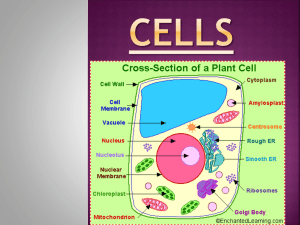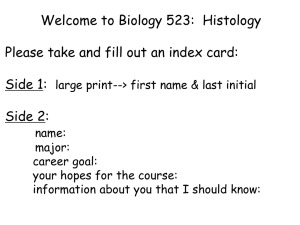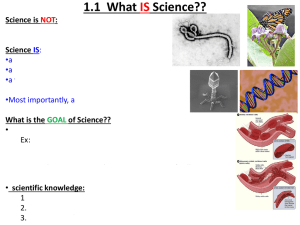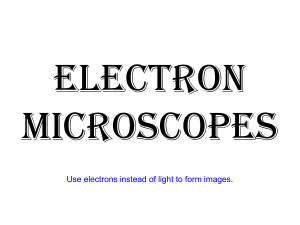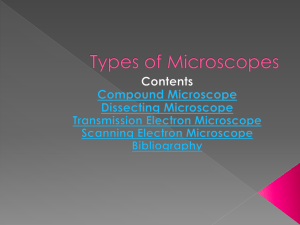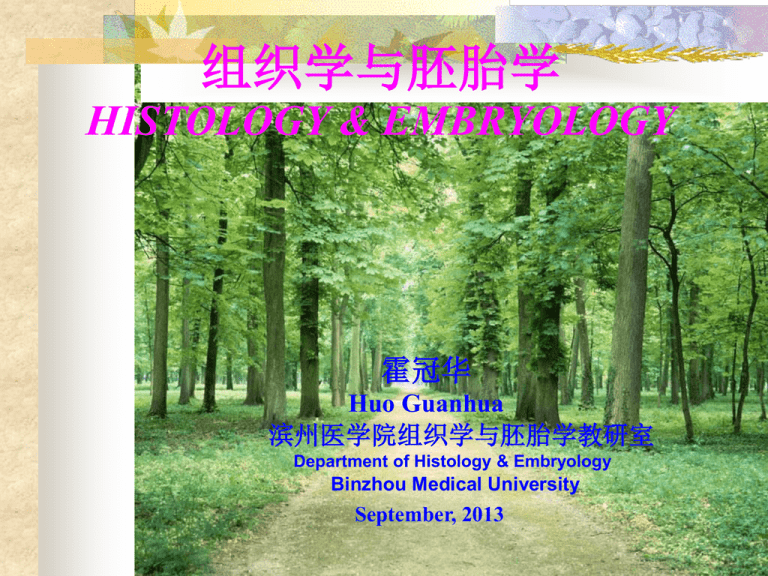
组织学与胚胎学
HISTOLOGY & EMBRYOLOGY
霍冠华
Huo Guanhua
滨州医学院组织学与胚胎学教研室
Department of Histology & Embryology
Binzhou Medical University
September, 2013
第1章 绪论 Chapter 1 Introduction
Histology & Embryology is composed of 2
related sciences.
一、组织学与胚胎学的研究内容及意义
The contents and importance of H&E
组织学(histology):是研究机体微细结构及
其相关功能的科学。
在组织、细胞、亚细胞和分子水平对机体进
行研究
A science: study normal micro-structure & its
related function of human body.
光镜结构:Microstructure
电镜结构: Ultrastructure
描述组织学与描述胚胎学descriptive histology &
embryology :用显微镜观察人体组织结构和胚胎发生过
程形态演变的科学。
Descriptive histology & embryology : Observes human tissue
structures and the process of embryogenesis and the
development.
比较组织学与比较胚胎学comparative histology and
embryology:比较不同种系动物的组织结构功能和胚胎发
育过程的科学。
Comparative histology and embryology: Compares tissue
structure and the process of embryogenesis and the
development in different species.
实验组织学与实验胚胎学experimental histology and
embryology:应用实验方法研究细胞与组织之间的
关系,以及理化因子或生物因素对组织结构功能和
生长发育的影响、作用机理及其防治的科学。
Experimental histology: Studies the relationship
between cells and tissues in vivo.
Experimental embryology: Studies the mechanisms
controlling the individual development of animals,
even human being, by means of experiments in vivo,
using such methods as marking, removal,
transplantation, and isolation of body parts and
organs. It also studies the action of various external
factors (physical, chemical or biological factors) on
embryonic development, and explores control or
prevention methods.
Experimental embryology identifies the stages of
the determination of the material of rudimentary
organs and tissues, the sources of formative or
inductive influences, the role of synthesis of
macromolecules in the processes of determination
and differentiation, and the factors responsible for
morphogenesis. By removing, inactivating, or
transplanting cell nuclei, experimental
embryologists investigate the interaction of the
nucleus and cytoplasm during gametogenesis and
embryonic development, as well as the stages and
factors of differential activation of genes in the
course of development.
-致病、致畸、致突变、致癌Pathogenicity test,
teratology test, mutagenic test and carcinogenicity
test
分子生物学和分子胚胎学molecular biology and molecular
embryology:从分子水平研究生命活动的物质基础及其异常
变化的科学。
Molecular biology and embryology: Studies molecules
responsible for structure, morphogenesis and functions in
human body and embryo.
Molecular biology is the study of biology at a molecular level.
The field overlaps with other areas of biology and chemistry,
particularly genetics and biochemistry. Molecular biology
chiefly concerns itself with understanding the interactions
between the various systems of a cell, including the
interactions between DNA, RNA and protein biosynthesis as
well as learning how these interactions are regulated.
Molecular embryology studies molecules responsible for
morphogenesis and functions during gametogenesis配子形成
and embryonic development.
组织(tissue):
由细胞和细胞外基质 extracellular matrix构成。
人体(基本)组织:上皮组织、结缔组织、肌组织和神经组织---胚胎发生来源、
细胞构成、形态特点和功能等方面,具有明显的特性。
Tissue is composed of cells and extracellular
matrix;collections of cells with similar morphological
characteristics:
Original 4 types of (basic, primary, or fundamental) tissues:
Epithelial tissues – surface coverage
Muscular tissues – contractile property
Nervous tissues – cells forming brain, spinal cord, and
nerves
Connective tissues – to link or support other specialized
tissues
Tissues are different from each other in their origin,
cellulosity细胞构成 , morphological characteristics and
functions.
器官organ:四种基本组织以不同的种类、数量
和方式组合形成器官。
系统system:若干功能相关的器官构成系统。
Each of the fundamental tissues is formed by several
types of cells and typically by specific associations of
cells and extracellular matrix. These characteristic
associations facilitate the recognition of the many
subtypes of tissues. Most organs are formed by an
orderly combination of several tissues, except the
central nervous system, which is formed almost
solely by nervous tissue. The precise combination of
these tissues allows the functioning of each organ
and of the organism as a whole.
A system is a group of organs that work together and
perform one or more functions.
细胞外基质extracellular matrix:
The extracellular matrix (ECM) is the noncellular component
present within all tissues and organs, and provides not only
essential physical scaffolding for the cellular constituents but
also initiates crucial biochemical and biomechanical cues
that are required for tissue morphogenesis, differentiation
and homeostasis. The importance of the ECM is vividly
illustrated by the wide range of syndromes, which can be
anything from minor to severe, that arise from genetic
abnormalities in ECM proteins. Although, fundamentally,
the ECM is composed of water, proteins and
polysaccharides, each tissue has an ECM with a unique
composition and topology that is generated during tissue
development through a dynamic and reciprocal, biochemical
and biophysical dialogue between the various cellular
components (e.g. epithelial, fibroblast, adipocyte, endothelial
elements) and the evolving cellular and protein
microenvironment.
细胞 Cell
构成:细胞膜、细胞质和细胞核,不同的细胞有不同的亚细胞结构特点。
The cell is the basic structural, functional and biological unit of all known
living organisms. Cells are the smallest unit of life that is classified as a
living thing, and are often called the "building blocks of life".
Cells consist of a protoplasm enclosed within a membrane, the cell
membrane or plasma membrane, which contains many biomolecules
such as proteins and nucleic acids. Organisms can be classified as
unicellular (consisting of a single cell; including most bacteria) or
multicellular (including plants and animals). While the number of cells
in plants and animals varies from species to species, humans contain
about 100 trillion (1014) cells. Most plant and animal cells are between 1
and 100 micrometres and therefore are visible only under the
microscope.
The cytoplasm comprises cytosol (or intracellular fluid (ICF) or cytoplasmic
matrix) – the gel-like substance enclosed within the cell membrane –
and the organelles – the cell's internal sub-structures. Within the cells of
eukaryote organisms the contents of the cell nucleus are separated from
the cytoplasm, and are then called the nucleoplasm. The cytoplasm is
about 70% to 90% water and usually colorless.
亚细胞结构:
A subcellular structure is simply structures within a cell.
They are smaller than a cell and commonly means
within a cell. They are individual components of a cell
that when put together forms a complete cell.
Subcellular structures can only be seen by an electron
microscope, either SEM or TEM microscopy.
Examples of subcellular structures are organelles Golgi apparatus, smooth and rough endoplasmic
reticulum, nucleus and mitochondria.
各种分子,其中生物大分子,特别是核酸、蛋白质是决
定细胞形态和功能的关键因素。
Molecules, among them the biomacromolecules, especially
nucleic acid and proteins, determine forms and
functions of cells.
胚胎学embryology:
研究个体发生、发育及其机制的学科,包括:胚胎早期发育和
各器官系统发育,先天性畸形及其成因。
与组织学互相联系,但相互独立。
Embryology is a science which is about the development of an embryo from
the fertilization of the ovum to the fetus stage, mainly concerning the
developmental processes and mechanism of a human being, is divided
into general embryology that studies the formations and development of
germ cells, fertilization and early development of human embryo, and
special embryology that studies the formation and malformations of
different organs. It also studies the causes inducing malformations.
Embryology and Histology are connected with each other, and are separated
from each other.
Conception
5weeks
畸形学Teratology:研究致畸因子作用和先天性畸形的成因及预防的科学
Teratology is the study of abnormalities of physiological development. It is
often thought of as the study of human birth defects, but it is much
broader than that, taking in other non-birth developmental stages,
including puberty; and other non-human life forms, including plants. A
newer term developmental toxicity includes all manifestations of
abnormal development, not only frank terata. These may include growth
retardation or delayed mental development without any structural
malformations.
Anencephaly
[ænən'sefəlɪ]
Cyclopia
学习组织学与胚胎学的意义
学习其他相关学科的前提:
病理学Histology and Pathology:
Histology: observe the conditions of cells and tissues under disease-free
condition.
Pathology: observe the changes of cells and tissues by the disease processes.
生理学
其他学科:儿科学、内科学、外科学、 妇产科学
科学研究:
Research
The subject no longer merely deals with the structure of the body; it also
concerns itself with the body’s function. In fact, histology has a direct
relationship to other disciplines and is essential for their understanding.
You will recognize the importance of this subject as they refer to the text
later in your careers. An excellent example of this relationship will be
evident when the reader learns about the histology of the kidney and
realizes it is the intricate and almost sublime structure of that organ (down
to the molecular level) that is responsible for the kidney’s ability to
perform its function. Alterations of the kidney’s structure are responsible
for a great number of life-threatening conditions.
This program includes lectures and laboratory
practices. The fast developing Histology &
Embryology is a main and fundamental course for
different specialty of medicine, and makes the
students know the basic knowledge and techniques,
and acquire the ability to analyze and solve
problems in further studies in other medical
courses and clinic management, even in your
future careers.
The remainder of this chapter will discusses the
methods used by histologists and embryologists.
二、当代组织学与胚胎学 Modern H & E
电子显微镜( electron microscope,简称电镜) 的发明
和超微结构的发现
The German physicist Ernst Ruska and the
electrical engineer Max Knoll constructed the
prototype electron microscope in 1931, capable of
four-hundred-power magnification; the apparatus
was the first demonstration of the principles of
electron microscopy. Two years later, in 1933,
Ruska built an electron microscope that exceeded
the resolution attainable with an optical (light)
microscope. Moreover, Reinhold Rudenberg, the
scientific director of Siemens-Schuckertwerke,
obtained the patent for the electron microscope in
May 1931.
分辨率达0.2nm。20年后发展了超薄切片术;扫描电镜出
现。可以观察细胞膜、细胞器、染色体、细胞间纤维成分
的超微结构(ultrastructure),发现了组织、器官中的大
量新的细胞种类、各种细胞间的连接和空间配置关系---达
到亚细胞水平。
The maximizing resolution power of an electron
microscope may reach 0.2nm. Microtomy was developed,
after that 20 years, and then, scanning electron microscope
was invented. Subcellular structures, such as plasma
membrane and organelles, were seen with the aid of
electron microscopy. The structures visible under the
electron microscope is termed ultrastructure.
普通光学显微镜和电子显微镜观察常用长度单位:
毫米 mm, millimeter;微米μm, micrometer;纳米nm,
nanometer
Length units commonly used in microscopy and EM are mm,
μm (1/1000mm)and nm (1/1000 μ m).
近代组织学与胚胎学进展:
改进、发展各种技术,大量使用新仪器、技术:
图像分析仪image analyzer 、共焦激光扫描显微
镜Confocal Laser Scanning Microscope 、流式细
胞术flow cytometry, FCM ,免疫组织化学
Immunocytochemistry。
With development and advance in sciences and the
advent of new technology, many new instruments
and technique were applied by histologists and
embryologists.
Confocal Laser Scanning Microscope
Image analyzer
Flow cytometry, FCM
Immunocytochemistry, and so on
三、组织学与胚胎学的研究方法
Research methods used in Histology and Embryology:
组织学技术种类繁多,其原理涉及物理、化学、生物化学、免
疫学、分子生物学等知识
The small size of cells and matrix components makes
histology dependent on the use of microscopes. Advances in
physics, chemistry, biochemistry, physiology, immunology,
molecular biology and pathology—and the interactions
among these fields—are essential for a better knowledge of
tissue biology. Familiarity with the tools and methods of any
branch of science is essential for a proper understanding of
the subject. This chapter reviews some of the more common
methods used to study cells and tissues and the principles
involved in these methods.
(一)一般光学显微镜技术 Light (Optical) microscopy
常用光镜标本制备
石蜡切片(paraffin sectioning):
①取材和固定Tissue Specimen collection and fixation:
固定剂—蛋白质凝固剂:常用甲醛formaldehyde--在很大程度上保存组织的
原本结构。组织块一般不超1.0cm大小。
To avoid tissue digestion by enzymes present within the cells (autolysis) or
by bacteria and to preserve the structure and molecular composition,
pieces of organs should be promptly and adequately treated before or as
soon as possible after removal from the body. This treatment—fixation —
can be done by chemical or, less frequently, physical methods. In chemical
fixation, the tissues are usually immersed in solutions of stabilizing or
cross-linking agents called fixatives. Because the fixative needs some time
to fully diffuse into the tissues, the tissues are usually cut into small
fragments (about 1.0cm in length, width and thickness ) before fixation to
facilitate the penetration of the fixative and to guarantee preservation of
the tissue. The most common fixative for light microscopy is 10% neutral
buffered formalin (4% formaldehyde in phosphate buffered saline).
Tissue preparation
A. paraffin section preparation
Specimen: as fresh as possible
Fixation: fixative: formalin solution;
purpose: to preserve the structural
organisation
l Dehydration: replace the water in the tissue
by alcohol
Clearing: replace the alcohol by xylene
Embedding: replace the xylene w/ melted
paraffin
Sectioning & mounting
The fixative preserves tissues or cells mainly by irreversibly
cross-linking proteins. The main action of these aldehyde
fixatives is to cross-link amino groups in proteins through
the formation of methylene bridges (-CH2-), in the case of
formaldehyde. This process, while preserving the structural
integrity of the cells and tissue can damage the biological
functionality of proteins, particularly enzymes, and can also
denature them to a certain extent. This can be detrimental
to certain histological techniques. Further fixatives are often
used for electron microscopy such as osmium tetroxide or
uranyl acetate.
Formalin fixation leads to degradation of mRNA, miRNA
and DNA in tissues. However, extraction, amplification and
analysis of these nucleic acids from formalin-fixed, paraffinembedded tissues is possible using appropriate protocols.
② 脱 水 dehydration 和 包 埋 embedding : 梯 度 酒 精
ascending graded ethanol脱去固定好的组织块中
的水分;二甲苯dimethylbenzene; xylene; xylol
置换组织中的酒精—不溶于石蜡;浸蜡—将组织块
置 于 融 化 的 石 蜡 paraffin; paraffin wax;
paraffine 中 , 让 石 蜡 浸 入 组 织 细 胞 , 冷 却 — 蜡
块—具有石蜡的硬度。
Biological specimens often need to be solidified to allow
fine sectioning. Embedding materials include
paraffin and plastic resins. Paraffin is used routinely
for light microscopy; resins are used for both light
and electron microscopy.
Tissue blocks are first stabilized by fixatives. Then:
Dehydration: Blocks are dehydrated in ascending graded
ethanol series (usually from 70% to 100% ethanol ).
Clearing: The ethanol is then replaced with a solvent miscible
with the embedding medium. In paraffin embedding, the
solvent used is usually xylene. As the tissues are infiltrated
with the solvent, they generally become transparent
(clearing).
Embedding: The blocks are embedded in paraffin wax which is
the typical embedding medium for routine histology.
Once the tissue is impregnated with the solvent, it is placed in
melted paraffin (paraffin wax ) in the oven, typically at 58–
60℃. The heat causes the solvent to evaporate, and the spaces
within the tissues become filled with paraffin. The tissue
together with its impregnating paraffin hardens after being
taken out of the oven.
Tissue processing Embedding moulds: (A) paper boat; (B)
metal boat mould; (C) Dimmock embedding mould; (D)
Peel-a-way disposable mould; (E) base mould used with
embedding ring ( F) or cassette bases (G)
③切片Sectioning和染色staining:用切片机将组织切
为5-10μm薄片,贴在载玻片上,脱蜡,水化(由
高到低浓度酒精descending grades of alcohol ,到
水),染色。
The hard blocks containing the tissues are then taken
to a microtome and are sectioned by the
microtome’s steel or glass blade to a thickness of 110μm. The sections are floated on water and
transferred to glass slides to be stained.
Because many tissue constituents have approximately
the same optical densities, they must be stained for
light microscopy, usually with watersoluble stains.
Therefore, the paraffin must first be removed from
the section, after which the tissue is rehydrated and
stained.
After staining, the section is again dehydrated so that the
coverslip may be permanently affixed by the use of a
suitable mounting medium. The coverslip not only protects
the tissue from damage but also is necessary for viewing
the section with the microscope.
Various types of stains have been developed for
visualization of the many components of cells and tissues;
they may be grouped into three classes:
Stains that differentiate between acidic and basic
components of the cell
Specialized stains that differentiate the fibrous
components of the extracellular matrix
Metallic salts that precipitate on tissues, forming
metal deposits on them
The most commonly used stains in histology are
hematoxylin and eosin (H&E).
④封片Mounting:切片经脱水—梯度酒精(由低浓度到高浓
度),滴加树胶,盖玻片密封保存。
The final step in this procedure is to permanently mount the
sections under a coverslip. This is accomplished by covering
the section in a medium that will harden and produce a clear
binder between the slide and coverslip. The ideal mounting
medium should not distort the stain color, or yellow and
become brittle with age.
Rinsing, Dehydration & Mounting Prep
water
70 % ethanol 2-3 minutes
80 % ethanol 2-3 minutes
95% ethanol 2-3 minutes
100% ethanol 2-3 minutes
Clearing Agent 10 minute
Clearing Agent 10 minute
I used mounting resin called Permount (Fisher Scientific)
and Neutral balsam.
How to get tissues for study?
Steps in tissue preparation
Fresh tissues from the body
1. fixation Formalin ( 10% formaldehyde)
Osmium tetroxide for EM
Mechanism - Forms cross links with proteins (Lysine)
2. Embedding – gives support for tissue slicing
Paraffin or plastic resin
3. Washing & dehydration (dehydration by graded
alcohols in ascending order)
4. clearing – to remove paraffin & alcohol By xylol
5. block making
10. dehydrate and Clearing
6. section cutting – 5-10μ thick sections with microtome
7. mounting – on glass slide ( adhesive – albumin)
8. clearing – xylol
9. rehydrate – alcohols in descending order
staining nuclear stain – Hematoxylin ( basic stain &
water soluble)
counter stain – Eosin ( less water soluble but soluble
in alcohol) – dehydrate in ascending order
– alcohols in ascending order
– xylol
11.Mounting medium – cover glass
Staining
Purpose: To make tissue section pigment
for observation.
H-E Staining:
Hematoxylin: basic dye, purple-blue
Eosin: acid dye, pink color
Basophilic: components bonded by basic
dye (H); pruple-blue(nuclear chromatin
& basophilic substance in cytoplasm)
Acidophilic: components bonded by acidic
dye (E); pink (cytoplasm & collagenous fiber)
Neutrophilic: do not stain w/ both basic and acid dyes
Metachromasia: a dye stains tissue a different color from
that of dye solution, e.g. toluidine blue stains mast
cells in purple color
With few exceptions, most tissues are colorless, so observing them
unstained in the light microscope is useless. Methods of staining tissues
have therefore been devised that not only make the various tissue
components conspicuous but also permit distinctions to be made between
them. The dyes stain tissue components more or less selectively. Most of
these dyes behave like acidic or basic compounds and have a tendency to
form electrostatic (salt) linkages with ionizable radicals of the tissues.
Tissue components, such as ribosomes that stain more readily with basic
dyes are termed basophilic , so basophilia is the affinity of cellular structures
for basic dyes, such as methylene blue; those with an affinity for acid dyes
are termed acidophilic, acidophilia is the affinity of cellular structures for
acidic dyes, such as eosin. Those with an weak affinity for both basic dyes
and acid dyes are termed neutrophilic, neutrophilia is the affinity of
cellular structures for neutral dyes
Hematoxylin behaves like a basic dye, that is, it stains the basophilic
tissue components. The main tissue components that ionize and react
with basic dyes do so because of acids in their composition (nucleic acids
and acid glycoproteins). Acid dyes (eg, orange G, eosin, acid fuchsin)
stain the acidophilic components of tissues such as mitochondria,
secretory granules, and collagen.
苏木精—伊红染色法(HE染色法)
(hematoxylin-eosin staining)
二甲苯 二甲苯 100%
1
2
酒精
在染色缸中
二甲苯 二甲苯 100%
2
1
酒精
苏木精
100% 95%酒 95%酒 85%酒 75%酒 染色液
酒精
精
精
精
精
水
洗
盐酸酒
精
水
洗
100% 95%酒 95%酒 85%酒 75%酒
伊红染
酒精
精
精
精
精
色液
Hematoxylin and Eosin (H & E) Staining
H & E is a charge-based, general purpose stain.
Hematoxylin stains acidic molecules shades of blue.
Eosin stains basic materials shades of red, pink
and orange. H & E stains are universally used for
routine histological examination of tissue sections.
Fixation
Any well fixed tissue.
Staining Procedure
1- Deparaffinize and hydrate to water
2- If sections are Zenker-fixed, remove the mercuric
chloride crystals with iodine and clear with sodium
thiosulphate (hypo)
3- Hematoxylin for 15 minutes
4- Wash in running tap water for 20 minutes
5- Counterstain with eosin from 15 seconds to 2 minutes
depending on the age of the eosin, and the depth of the
counterstain desired. For even staining results dip slides several
times before allowing them to set in the eosin for the desired time
6- Dehydrate in 95% and absolute alcohols, two changes of 2
minutes each or until excess eosin is removed. Check under
microscope
7- Clear in xylene, two changes of 2 minutes each
8- Mount in Permount or Histoclad
Results
Nuclei - blue - with some metachromasia
Cytoplasm - various shades of pink-identifying different tissue
components
切片及染色设备
自动染色机
切片机及其它设备
Microtome for sectioning resin- and
paraffin-embedded tissues for light
microscopy. Rotation of the drive wheel
moves the tissue-block holder up and
down. Each turn of the drive wheel
advances the specimen holder a
controlled distance, generally between 1
and 10μ m. After each forward move, the
tissue block passes over the knife edge,
which cuts the sections.
其他:
火棉胶包埋celloidin embedding,火棉胶切片机切片:制
作大组织块切片。
Nitrocellulose, otherwise known as cellulose nitrate, goes by
several names. The commonest, in the histological world, are
celloidin and collodion. Tissues embedded in celloidin are
usually sectioned with a sliding microtome. In this
instrument the block is mounted on a platform facing
upwards and is fixed. The knife is held at a significant slant
so that most of the blade edge is used during the cutting
stroke, and is quite long,
often in excess of 25 cm.
冰冻切片frozen section:
新鲜组织,液氮liquid nitrogen (-1960C)冷冻,恒冷
箱切片机cryostat microtome—检查组织化学、酶等
Cryostat are used in medicine to cut histological
slides. They are usually used in a process called
frozen section histology. The cryostat is
essentially an ultrafine "deli-slicer", called a
microtome, placed in a freezer. The cryostat is
usually a stationary upright freezer, with an
external wheel for rotating the microtome. The
temperature can be varied, depending on the
tissue being cut - usually from minus 20 to
minus 30 degree Celsius. The freezer is either
powered by electricity, or by a refrigerant like
liquid nitrogen.
1. Freeze a fresh, unfixed tissue sample, up to 2.0 cm in
diameter, in OCT in a suitable tissue mold. Freeze the OCT
containing the tissue onto the specialized metal grids that
fit onto the cryostat.
OCT is viscous at room temperature and miscible with
H2O, but freezes into a solid support at −20°C.
Certain soft tissues, such as brain, are optimally frozen in
M-1 medium at −3°C.
2. Cut sections 5-15 μm thick in the cryostat at −20°C. If
necessary, adjust the temperature of the cutting chamber
±5°C, according to the tissue under study.
OCT :Optimal Cutting Temperature Compound, the
formulation of water-soluble glycols and resins, is used to
embed tissue samples prior to frozen sectioning on a
microtome-cryostat. This process is undertaken so as to
mount slices (sections) of a sample onto slides for analysis.
特殊染色Histology Special Stains
硝 酸 银 ( 镀 银 ) 染 色 Silver impregnation, silver
staining,染神经细胞,纤维成分等。
某些结构经硝酸银处理使硝酸银还原,形成银微粒附
在组织结构上-棕黑色,此性质称亲银性
(argentaffin)。有些组织结构不能使硝酸银还原,
需加还原剂使硝酸银还原,称为嗜银性
(argyrophilia)。
Silver (Silver nitrate) staining( Silver impregnation )
aids the visualisation of targets of interest, namely
intracellular and extracellular cellular components
such as DNA and proteins, such as type III collagen
and reticulin fibres by the deposition of metallic
silver particles on the targets of interest.
Argentaffin: Of or relating to cells or tissue elements that
reduce silver ions in solution, thereby staining brown or
black. In the argentaffin reaction, the tissue contains
reducing groups that are sufficiently strong and present in
sufficient quantity to give a visible deposit without added
reducing agents. These groups are often aldehyde groups
and silver solutions can be used to replace the Schiff ’s
reagent in the PAS technique to give periodic acid–silver.
Argyrophilia: Many tissue groups are able to adsorb silver,
possibly by ionic mechanisms as for dyeing. The silver is
mainly adsorbed as silver ions but small amounts are
reduced to silver atoms. These silver atoms are deposited at
the site of reduction. The initial reduction reaction with
silver only deposits submicroscopic atoms of silver at
particularly reactive sites. In this case the developer does
the main reduction and the tissue simply provides places
where there are silver atoms to catalyse the reduction. This
type of reaction where an external reducer or developer is
added is called an argyrophilic reaction.
异染性metachromasia:
用甲苯胺蓝等碱性染料染色呈紫红色。
The term metachromasia is used when a dye stains
a tissue component a different color to the dye
solution. For example, toluidine blue is a strong
basic blue dye that stains nuclei a deep blue color;
however, it will also stain mast cell granules a pink
color. This color shift that occurs with mast cells is
called metachromasia, whilst the usual blue
staining is called orthochromasia.Many dyes can
show metachromasia but the thiazine group dyes
are especially good for this type of staining.
Silver staining of
the neuron and
the bile canaliculi
HO (Hoechst 33258)PI staining shows the
apoptosis in human
HL-60 cells
涂片smear:直接将细胞(如血细胞)涂于玻片上,
制作血涂片、细胞涂片等。
Smear:A small quantity of cells (e.g. blood cells,
cells collected by a swab or cultured ) spread
thinly on a slide for microscopic examination.
铺片:将组织撕成薄片铺在载玻片上,制作结缔
组 织 铺 片 、 肠 系 膜 铺 片 等 。 Whole-mounts,
stretched preparation, where an entire organism
or structure is small enough or thin enough to be
placed directly onto a microscope slide (e.g. a
small unicellular or multicellular organism or a
membrane that can be stretched thinly on to a
slide)
磨片ground section:将硬组织磨成薄片,制作骨
磨片、牙磨片等。
A ground section, (e.g. bone), refers to a microscope
slide of bone that is prepared by taking a larger
piece of the bone and placing it between two pieces
of abrasive material--such as carbide paper. These
are rotated and "grind" the section down until the
bone is adequately thin to transmit incident light in
a light microscope, allowing for observation of the
bone structure. This section is then transferred to a
glass slide, mounted, and cover slipped.
显微镜: Microscopy
Light microscopy
Conventional light, phase contrast, differential interference,
polarizing, confocal, and fluorescence microscopy are all
based on the interaction of light and tissue components.
With the light microscope, stained preparations are usually
examined by means of light that passes through the
specimen. The microscope is composed of mechanical and
optical parts. The optical components consist of 3 systems:
condenser, objective, and eyepiece. The condenser collects
and focuses light, producing a cone of light that illuminates
the object to be observed. The objective lenses enlarge and
project the illuminated image of the object in the direction
of the microscope. The microscope further magnifies this
image and projects it onto the viewer’s retina, a
photographic plate, or ( to obtained by digital image) a
detector such as a charged coupled device (CCD电荷耦合设
备 ) camera. The total magnification is obtained by
multiplying the magnifying power of the objective and
ocular lenses.
3、荧光显微镜(fluorescence microscope):
使用荧光染料染色或作为标记物,以紫外线为
光源,激发染料发出荧光。
Fluorescence Microscopy
When certain substances are irradiated by light of a certain wavelength,
they emit light with a longer wavelength. This phenomenon is called
fluorescence. In fluorescence microscopy, tissue sections are irradiated
with either ultraviolet (UV) light or laser, and the emission is in the
visible portion of the spectrum. The fluorescent substances appear
brilliant or colored on a dark background. For this method, the
microscope has a strong UV light source and special filters that select
rays of different wavelengths emitted by the substances.
Fluorescent compounds that have an affinity for cell macromolecules
may be used as fluorescent stains. Acridine orange, which can combine
with DNA and RNA, is an example. When observed in the fluorescence
microscope, the DNA–acridine orange complex emits a yellowish-green
light, and the RNA–acridine orange complex emits a reddish-orange light.
It is thus possible to identify and localize nucleic acids in the cells .
Another important application of fluorescence microscopy is achieved by
coupling fluorescent substances (such as fluorescein
isothiocyanate[ɪsəʊθɪəʊ'sɪəneɪt] , FITC) to marker molecules that will
specifically bind to components of the tissues and will thus allow the
identification of these components under the microscope.
(二)电镜术Electron microscopy
用电子束代替可见光,电磁透镜代替光
学透镜,用荧光屏将肉眼不可见的电子
束呈像。
Transmission and scanning electron
microscopes are based on the interaction
of electrons and tissue components.
透射电镜(transmission electron
microscope, TEM):
Transmission Electron Microscope (TEM)
Using a beam of electrons (short wave-lengths) instead of
visible light.
Section preparation:
similar to those for L.M mainly,
glutaraldehyde, osmium tetroxide instead of Formalin (
10% formaldehyde)
plastic, resin, instead of paraffin,
50-70nm thick, ultramicrotome
heavy metal saltsuranyl acetate, lead citrate, instead of HE.
Resolution: 0.1-0.5nm (0.2nm)
Ultrastructrue: The structure in EM
Electron-dense/ electron lucent: Dark areas of an electron
micrograph are usually called electron dense, whereas light
areas are called electron lucent
Schematic view示意图 of a transmission electron microscope with its
lenses and the pathway of the electrons. CCD, charged coupled device.
Diagrams of TEM
The transmission electron microscope functions on the
principle that a beam of electrons can be deflected by
electromagnetic fields in a manner similar to light deflection
in glass lenses. In the electron microscope, electrons are
released by heating a very thin metallic (usually tungsten)
filament (the cathode阴极,负极 ) in a vacuum. The
electrons released are then submitted to a voltage difference
of 60–120 kV between the cathode and the anode阳极 ,
which is a metallic plate with a hole in its center. Electrons
are thus attracted to the anode and accelerated to high
speeds. They pass through the central opening in the anode,
forming a constant stream (or beam) of electrons that
penetrates the tube of the microscope. The beam passes
inside electric coils and is deflected in a way roughly
analogous to what occurs in optical lenses, because electrons
change their path when submitted to electromagnetic fields.
For this reason, the electric coils of electron microscopes are
called electromagnetic lenses.
The configuration of the electron microscope is very similar to that of the
optical microscope, although the optics of the electron microscope are
usually placed upside down. The first lens is a condenser that focuses the
beam of electrons on the section. Some electrons interact with atoms of
the section and continue their course, whereas others simply cross the
specimen without interacting. Most electrons reach the objective lens,
which forms a magnified image that is then projected through other
magnifying lenses. Because the human eye is not sensitive to electrons, the
image is finally projected on a fluorescent screen or is registered by
photographic plates or a charged coupled device camera. Because most of
the image in the TEM is produced by the balance between the electrons
that hit the fluorescent screen (or the photographic plate) and the
electrons that are retained in the tube of the microscope, the resulting
image is always in black and white.
To provide a good interaction between the specimen and the electrons,
electron microscopy requires very thin sections (40–90 nm); therefore,
embedding is performed with a resin that becomes very hard. The blocks
thus obtained are so hard that glass or diamond knives are usually
necessary to section them. The extremely thin sections are collected on
small metal grids and transferred to the interior of the microscope to be
analyzed.
电镜细胞化学技术(electron microscope
cytochemistry):组织化学与电镜技术结合
免疫电镜术(immuno-electron
microscope):免疫细胞化学与电镜结合
电镜放射自显影术(electron microscope
autoradiography):电镜技术与显微放射
自显影术结合
冷冻蚀刻法(freeze etching method):用
电镜观察细胞断裂面形态结构的一种冷冻
干燥技术。
冷冻蚀刻法 freeze etching method or Freeze fracture
A method of specimen preparation for the electron microscope in which
rapidly frozen tissue is cracked so as to produce a fracture plane
through the specimen. The surface of the fracture plane is then
shadowed by heavy Metal vapour, strengthened by a carbon film and the
underlying specimen is digested away, leaving a replica that can be
picked up on a grid and examined in the transmission electron
microscope. The great advantage of the method is that the fracture plane
tends to pass along the centre of lipid bilayers and it is therefore possible
to get en face views of membranes that reveal the pattern of integral
membrane proteins. The e face is the outer lamella of the plasma
membrane viewed as if from within the cell, the p face the inner lamella
viewed from outside the cell. Fracture planes also often pass along lines
of weakness such as the interface between cytoplasm and membrane, so
that outer and inner membrane surfaces can be viewed. Further
information about the structure can be revealed by freeze etching.
Extremely rapid freezing followed by deep etching has allowed the
structure of the cytoplasm to be studied without the artefacts that might
be introduced by fixation.
It is a technique used to look at membranes that reveal the
pattern of integral membrane proteins.
General outline of technique:
1. Cells are quickly frozen in liquid nitrogen (196C), which
immobilizes cell components instantly.
2. Block of frozen cells is fractured. This fracture is
irregular and occures along lines of weakness like the
plasma membrane or surfaces of organelles.
3. Surface ice is removed by a vacuum (freeze etching)
4. A thin layer of carbon is evaporated vertically onto the
surface to produce a carbon replica.
5. Surface is shadowed with a platinum vapor.
6. Organic material is digested away by acid, leaving a
replica.
7. Carbon-metal replica is put on a grid and examined by a
transmission electron microscope.
(三)组织化学和细胞化学术
Histochemistry and cytochemistry
The terms histochemistry and cytochemistry are
used to indicate methods for localizing substances in
tissue sections. Several procedures are used to
obtain this type of information, most of them based
on specific chemical reactions or on high-affinity
interactions between macromolecules. These
methods usually produce insoluble colored or
electron-dense compounds that enable the
localization of specific substances by means of light
or electron microscopy.The specific substances can
be quantified by microspectrophotometry or image
analyzer.
A
+
tissue or cell
to be tested
B
chromogenic reagent
C↓
insoluble coloured compund
electron-dense compund
It is referred to as cytochemistry to detect some
substances in free cell samples using
techniques of histochemistry.
For instance:
PAS(Periodic Acid Schiff) reaction:
for manifesting polysaccharide and
proteoglycan (e.g. glycogen).
polysaccharide + periodic acid (HIO4)
(hydroxyl group)
(oxidise)
Aldehyde group + Shiff’s reagent
(colorless)
Purplish red depositor
Lipids
Lipids are best revealed with dyes that are soluble
in lipids. Frozen sections are immersed in alcohol
solutions saturated with the dye. Sudan IV and
Sudan black are the most commonly used dyes.
The dye dissolves in the cellular lipid droplets,
which become stained in red or black. Additional
methods used for the localization of cholesterol
and its esters, phospholipids, and glycolipids are
useful in diagnosing metabolic diseases in which
there are intracellular accumulations of different
kinds of lipids.
(3)核酸:福尔根反应(Feulgen reaction):稀
盐酸水解DNA,用希夫试剂处理——紫红色产物。
同时显示DNA和RNA,用甲基绿methyl green -派
若宁pyronine反应——甲基绿与细胞核DNA结合呈
蓝绿色,派若宁与核仁、胞质内的RNA结合呈红
色。
Nucleic Acids
DNA can be identified and quantified in cell nuclei
using the Feulgen reaction, which produces a red color
in DNA. DNA and RNA can also be analyzed by
staining cells or tissue sections with a basic stain, such
as methyl green –pyronine reaction, at the same
time.
(4)酶类enzymes :通过显示酶的催化活性表明酶的存
在。切片用含特异性底物的溶液孵育,底物经酶的作用形
成初级反应产物,它再与某种捕捉剂结合——形成镜下可
见的沉淀物。
酶多为蛋白质—免疫组化显示
Enzymes
Examples of enzymes that can be detected include the
following:
Phosphatases are enzymes widely found in the body. They
split the bond between a phosphate group and an alcohol
residue of phosphorylated molecules. The colored insoluble
reaction product of phosphatases is usually lead phosphate
or lead sulfide. Alkaline phosphatases, which have their
maximum activity at an alkaline pH, can be detected . Acid
phosphatases are frequently used to demonstrate lysosomes,
cytoplasmic organelles that contain acid phosphatase
Proteins
Although there are general methods to
detect proteins in tissue sections, the
histochemical methods usually do not
permit identification of specific proteins
in cells and tissues.
Immunocytochemistry, presented later
in this chapter, can do so.
荧光染色: Fluorescent staining
敏感性高
以紫外线照射荧光物质,激发荧光
自发荧光:组织中的某些成分
Vitamin A—自发绿色荧光
生物胺类:多巴胺、肾上腺素、5-羟色胺—甲醛处理, 不同
荧光
与荧光素结合发荧光:
荧光染料:吖啶橙—与DNA结合呈黄或黄绿色荧光,与
RNA 结合呈橘黄、橘红色荧光
Tissues or cells + fluorescein
fluorescence
Autofluorescence: Vitamin A-green; dopamine, adrenalin,
5-hydroxytryptamine (5-HT, serotonin ) after treating with
formaldehyde- different fluorescence
Fluorescent dyes: acridine orange, Hoechst 33258 and
33342, PI (Propidium iodide ),irradiated with ultraviolet
rays
Immunohistochemistry and Immunocytochemistry
Based on antigen binds to specific antibody.
Tissue section w/ Antigen +labeled antibody
labeled Ag-Ab complex
Fluorescein labeling enzyme labeling colloidal gold labeling
常用标记物:荧光素luciferin —用荧光显微镜观察;辣根
过氧化物酶horseradish peroxidase, HRP —经酶的组织化
学处理后用光镜或电镜观察;胶体金colloidal gold —电镜
观察。
Labeling with
luciferin, horseradish peroxidase, HRP ,
and colloidal gold (for EM)
HO (Hoechst 33258)PI staining shows the
apoptosis in human
HL-60 cells
FITC staining shows the
translocation of TFAR19
protein in HeLa cells induced
by staurosporin
Photomicrograph of a section of small intestine in which an antibody
against the enzyme lysozyme was applied to demonstrate lysosomes in
macrophages and Paneth cells. The brown color, indicating the presence
of lysozyme, results from the reaction done to show peroxidase, which
was linked to the secondary antibody. Nuclei were counterstained with
hematoxylin. Medium magnification.
Photomicrograph of kidney cells in culture, stained with acridine orange.
Under a fluorescence microscope, DNA (within the nuclei) emits yellow
light, and the RNA-rich cytoplasm appears reddish or orange. (Courtesy
of A Geraldes and JMV Costa.)
4、原位杂交术in situ hybridization
即核酸分子杂交组织化学术。
检测DNA、mRNA片段有无及活性—特异性
的核酸组织化学术。
用带标记的已知碱基顺序的核酸(DNA,
RNA)探针probe与细胞内待测核酸按碱基配对
原则,进行特异性原位结合-杂交,检测、显示
标记物,获得待测核酸的有无、相对量。
Hybridization Techniques
The central challenge in modern cell biology is to
understand the workings of the cell in molecular detail.
This goal requires techniques that permit analysis of the
molecules involved in the process of information flow from
DNA to protein. Many techniques are based on
hybridization. Hybridization is the binding between two
single strands of nucleic acids (DNA with DNA, RNA with
RNA, or RNA with DNA) that recognize each other if the
strands are complementary. The greater the similarities of
the sequences, the more readily complementary strands
form "hybrid" double-stranded molecules. Hybridization
thus allows the specific identification of sequences of DNA
or RNA.
In Situ Hybridization (ISH)
—nucleic acid molecular hybridization
Use nucleotide probe to check target fragment
of intracellular DNA or mRNA in situ, in
order to study the gene expression.
Tissue section of a benign epithelial tumor (condyloma) submitted to in situ
hybridization. The brown areas are places where DNA of human
papillomavirus type 2 is present. The counterstain was hematoxylin.
Medium magnification. (Courtesy of JE Levi.)
Hybridization can also be performed with purified DNA or
RNA in solid supports. Mixtures of DNA or RNA are
separated by electrophoresis in an agarose gel or a
polyacrylamide gel. After electrophoresis, the fragments of
nucleic acids are transferred to a nylon or nitrocellulose
sheet by solvent drag: a buffer flows through the gel and
membrane by capillarity, carrying the nucleic acid
molecules that bind strongly to the nylon or nitrocellulose
sheet, where the nucleic acids can be further analyzed. This
technique of DNA identification is called Southern blotting.
When electrophoresis of RNA is performed, the technique
is called Northern blotting.
Hybridization techniques are highly specific and are
routinely used in research, clinical diagnosis, and forensic
medicine.
Probs核酸探针的种类:
cDNA prob
cRNA prob
常用标记物:放射性核素—35S 、32P、3H—
经放射自显影术处理后观察;荧光素、生物
素、地高辛—小分子药物,经免疫组织化学
处理后观察
Markers commonly used for hybridization
include 35S, 32P, 3H, fluorescein, biotin, and
digoxin, which should be treated with IHC
for revewing.
原位杂交:
端粒酶在卵巢癌中的表达(地高辛标记)
Expression of telomerase in ovarian carcinoma
(labeled by digoxin)
组织培养或细胞培养术Cell & Tissue Culture
Live cells and tissues can be maintained and
studied outside the body. In a complex organism,
tissues and organs are formed by several kinds of
cells. These cells are bathed in blood plasma, which
contains hundreds of different molecules. Cell and
tissue culture has been very helpful in isolating the
effect of a single molecule on one type of cell or
tissue. It also allows the direct observation of the
behavior of living cells under a microscope. Several
experiments that cannot be performed in the living
animal can be reproduced in vitro.
The cells and tissues are grown in complex solutions of
known composition (salts, amino acids, vitamins) to
which serum components are frequently added. In
preparing cultures from a tissue or organ, cells
must be initially dispersed either mechanically or
by treating the tissue with enzymes. Once isolated,
the cells can be cultivated in a suspension or spread
out on a Petri dish or glass slide, to which they
adhere, usually as a single layer of cells . Cultures
of cells that are isolated in this way are called
primary cell cultures. Many cell types were once
isolated in this way from normal or pathological
tissue and have been maintained in vitro ever since
because they have been immortalized and now
constitute a permanent cell line.
Most cells obtained from normal tissues have a finite,
genetically programmed life span. Certain changes,
however (mainly related to oncogenes), can
promote cell immortality, a process called
transformation, which may be a first step in
transforming a normal cell into a cancer cell.
Because of transformation and other
improvements in culture technology, most cell
types can now be maintained in the laboratory
indefinitely. All procedures with living cells and
tissues must be performed in a sterile area, using
sterile solutions and equipment.
培养室及设备
细胞或组织化学定量术
Quantitative cyto- or histochemistry
显微分光光度定量术microspectrophotometry
显微镜技术+分光光度技术---定量检测细胞化学
成分:DNA、RNA、蛋白质、酶、脂类、糖类等
Microscopy + spectrophotometry
Quantitative analysis of the chemical composition
in cells, e.g. DNA,RNA, proteins, enzymes,
lipids and carbohydrates.
A microscopic thin beam of light enters the outersegment of
the receptor. Some of the light is absorbed by the
photopigment and the rest emerges to be captured by the
very sensitive detector. The difference between that which
enters the outersegment and that which emerges is the
amount that is absorbed. The technique measures the light
absorbed, reflected, or emitted by a microscopic specimen
at different wavelengths. Such a technique used to
characterize and quantify nucleoproteins in single cells or
cell organelles on the basis of their natural ultraviolet
absorption spectra or following stoichiometric binding in
selective cytochemical staining reactions.
流式细胞术flow cytometry:定量分析、分选流体单个
细胞及其它生物微粒—细胞大小、形态、细胞内颗
粒多少,荧光染色测DNA、RNA蛋白质、细胞膜
受体和抗原等
Flow cytometry (FCM) is a technique for counting and
examining microscopic particles, such as cells and
chromosomes, by suspending them in a stream of fluid and
passing them by an electronic detection apparatus.
It allows simultaneous multiparametric analysis of the physical
and/or chemical characteristics of up to thousands of
particles per second.
Flow cytometry is routinely used in the diagnosis of health
disorders, especially blood cancers, but has many other
applications in both research and clinical practice.
A common variation is to physically sort particles based on their
properties, so as to purify populations of interest.
The technology has applications in a number of fields, including
molecular biology, pathology, immunology, plant biology and
marine biology.
It has broad application in medicine (especially in
transplantation, hematology, tumor immunology and
chemotherapy, genetics and sperm sorting for sex
preselection) and so forth.
How to study Histology and Embryology
Describe the structures of major organ
Describe the structures of cells
what tissues
formation
distribute-where, how
morphological features-microstructure, ultrastructures
Understand the functions of the cells, organs and the
sysytems
Understand some molecules, especially
biomacromolecules, and their functions
Combine the 2 dimentional structure with 3 dimentional
Combine the theory with practice
Combine the structure with functions
主要参考书:References
全国高等学校教材:组织学与胚胎学, 第7版,邹仲
之 李继承主编,人民卫生出版社,2008年6月,
北京
Textbook of Histology and Embryology, 2d edition,
Gao Yingmao, Science Press, Beijing.
Basic Histology, Tenth Edition, Luiz Carlos
Junqueira, Jose Carneiro, McGraw-Hill
Companies, Inc., 2003
Basic Concepts in Embryology, Lauren J. Sweeney,
McGraw-Hill Companies, Inc., 1998
第2章
上皮组织Epithelial Tissue
相关知识导读
细胞与细胞是怎样连接在一起的?
胃肠的消化吸收功能由那种细胞参与的?
细胞间可以通过什么样的结构进行信息交
流?
头皮屑是怎么形成的?
痰液是如何形成及如何从气管中排出的?
上 皮 组 织 ( epithelial tissue ) 简 称 上 皮
(epithelium):由大量形态规则、排列密集的细
胞组成。上皮组织的特性:细胞多,排列密集。
上皮细胞具有明显的极性(polarity)—细胞不同
表面在结构和功能上有明显差别。有游离面:朝
向身体的表面或有腔器官的腔面。基底面:细胞
朝向深部结缔组织的面。侧面:上皮细胞之间的
连接面。上皮基底面附着在基膜上,并借此与结
缔组织相连。上皮内大多无血管—靠结缔组织内
的血管提供营养。
分类:主要为被覆上皮和腺上皮
功能:保护、吸收、分泌、排泄等。
一、被覆上皮(covering epithelium)
覆盖于身体表面,衬贴在体腔和有腔器官
内表面。
分类:根据构成细胞的层数和在垂直切面
上的形状分类。
被覆上皮的类型和主要分布
上皮类型
主要分布
—————————————————————————
单层 单层扁平上皮
内皮:心、血管、淋巴管腔面
上皮
间皮:胸膜、腹膜、心包膜
其它:肺泡、肾小囊壁层等
单层立方上皮
甲状腺滤泡、肾小管等
单层柱状上皮
胃、肠、胆囊、子宫等
假复层纤毛柱状上皮 呼吸管道等
复层 复层扁平上皮
未角化的:口腔、食道、阴道
上皮
角化的:皮肤表皮等
复层柱状上皮
眼睑结膜、男性尿道等
变移上皮
肾盂、肾盏、输尿管、膀胱等
—————————————————————————
1、单层扁平上皮(simple squamous epithelium):
也称单层鳞状上皮。
1、一层扁平细胞组成。
表面观:细胞不规则或多边形,核椭圆形,位
中央。细胞边缘呈锯齿或波浪状,互相嵌合。
单层扁平上皮垂切面观察:细胞扁薄,胞质很少,
含核部厚。分类:
内皮endothelium):衬在心血管和淋巴管腔面;
间皮(mesothelium):在胸膜、腹膜和心包膜表面。
微动脉纵切面
其它:肺泡、肾小囊
功能:主要是保持器官表面光滑,利于血液或
淋巴的流动,减少器官间的磨擦。
2、单层立方上皮(simple cuboidal epithelium):
由一层立方形细胞组成。
表面观:细胞呈六角形或
多角形。
垂直面观:细胞呈立方形,
核圆居中。
3、单层柱状上皮
simple columnar epithelium:
由一层棱柱状细胞组成。
表面观:细胞六角形或多边形。
垂直面:细胞为柱状,核长圆,常位细胞近
基底部,长轴与细胞长轴一致。
分布:胃肠、胆囊、子宫等。
有吸收、分泌功能
肠道的单层柱状上皮除
柱状细胞,还有散在的
杯状细胞(goblet cell):
高脚酒杯状,底部狭窄,
核深染,顶部膨大,充
满分泌颗粒—含有粘蛋
白—PAS反应阳性称粘
原颗粒mucinogen
granule
—分泌后与水结合成粘
液,润滑、保护上皮。
在子宫、输卵管等腔面
的,细胞游离面有纤
毛—单层纤毛柱状上皮
simple ciliated
columnar epithelium
4、假复层纤毛柱状上皮(pseudostratified ciliated
columnar epithelium):
主要在呼吸管道。
柱状细胞:最多,表面有纤毛
梭形细胞,锥形细胞,杯状细胞
细胞形态不同,
高矮不一,核
位置高低不齐,
细胞基部均附
于基膜
5、复层扁平上皮(stratified squamous epithelium):
表层细胞呈扁平鳞片状,又称复层鳞状上皮。
基底细胞:矮柱状,幼稚,有增殖分化能力。
中间:数层多边形细胞。表层:几层梭形或扁平细胞。
上皮与CT连接凹凸不平—增加连接面,保证供应,连接牢固。
分类:
角化的复层扁平上皮
位于皮肤表皮。浅层细胞的
核消失,胞质充满角蛋
白,细胞干硬,不断脱
落。
未角化的复层扁平上皮
位于:口腔、食管等腔面,
浅层细胞有核,角蛋白
少。
复层扁平上皮功能:
耐磨擦—保护,阻止异物
侵入,受伤后再生修复
能力强。
6、复层柱状上皮(stratified columnar epithelium):
浅层:为一层排列整齐的柱状细胞
深层:为一层或多层多边形细胞。
变移上皮
(transitional epithelium)
分布于排尿管道。
细胞分层:
表层细胞——大,厚,
称盖细胞。
中间层:细胞多边形
基底层:细胞较小。
特点:细胞形状、层次
随器官收缩、扩张状态
而变化——收缩时:上
皮变厚,细胞层数增多,
细胞大立方形;扩张时:
上皮变薄,细胞层数减
少,细胞呈梭形。
二、腺上皮和腺
腺上皮(glandular epithelium):由腺细胞
组成,以分泌功能为主的上皮。
以腺上皮为主要成分构成的器官称为腺。
腺细胞分泌物:酶类、糖(粘)蛋白、激素等。
分类:外分泌腺(exocrine gland)—有导管,
分泌物经导管排至体表或器官腔内。如汗
腺、唾液腺等。
内分泌腺(endocrine gland)—无导管,分
泌物(激素)释放入血液。如甲状腺、肾
上腺等。
外分泌腺的结构和分类
按细胞数目:单细胞腺
多细胞腺:
一般由分泌部和导管组成
外分泌腺腺泡与导管
外分泌腺:
导管部:无分支—单腺
有分支—复腺
分泌部:
管状、泡状、管泡状
单管状腺
单泡状腺
按形态 复管状腺
复泡状腺
复管泡状腺
1、分泌部secretory protion
一般由一层腺细胞组成,中央有腔。
形状:管状、泡状和管泡状
泡状和管泡状的分泌部称为腺泡(acinus)。
根据分泌部形状分:管状腺tubular gland、泡
状 腺 acinar gland和 管 泡 状 腺 tubuloacinar
gland。
腺细胞多呈锥形,由于分泌物不同形态各异
腺泡:Acinus
由腺细胞组成。消化、呼吸系统一般分为
浆液性和黏液性细胞。
1)蛋白质分泌细胞protien secreting cell
浆液性细胞(serous cell):
锥体形,核圆,
靠近细胞基底部。
基部胞质强嗜碱性,
顶部胞质有许多嗜
酸性的分泌颗粒—
酶原颗粒
zymogen granule
电镜:
胞质(尤其基部胞质)
有密集的粗面内质
网,核上区有发达
的高尔基复合体和
数量不等的分泌颗
粒-蛋白质分泌细胞
的超微结构特点
合成、分泌蛋白质。
分泌物:稀薄,含
有消化酶
2)糖蛋白分泌细胞glycoprotein secreting cell,黏
液性细胞mucous cell:
分泌糖蛋白(黏蛋白)
细胞锥体形,
核扁圆位细胞基部。
胞质色浅,含粘原颗粒,
HE片呈泡沫或空泡状。
核周少量胞质,嗜碱性。
电镜:基部胞质有较
丰富的粗面内质网,
核上高尔基复合体发达
有丰富、粗大的黏原颗
粒。分泌粘液。
杯状细胞:
散在的粘液性细胞
分泌过程:高尔基复合
体内合成多糖,并与
粗面内质网合成的蛋白
质结合—糖蛋白—分泌
颗粒—胞吐释放
杯
状
细
胞
电
镜
图
腺体:Glands
浆液性腺泡——由浆液性腺细胞组成;
粘液性腺泡——由粘液性细胞组成;
混合性腺泡——由两种细胞组成。
消化系统和呼吸管道的外分泌腺可分为:
浆液性腺:分泌部全由浆液性腺泡组成:腮腺
粘液性腺:分泌部全由粘液性腺泡组成:十二指肠腺
混合性腺:由三种腺泡组成:颌下腺、舌下腺
大部分混合性腺泡主要由粘液性腺泡组成,
少量浆液性腺泡位于腺泡底部,切片中呈半
月形—浆半月(serous demilune)。
粘液性细胞间隙局部扩大,形成分泌小管,
浆半月的分泌物经分泌小管释放入腺泡腔。
在汗腺、乳腺和唾液腺分泌部与基膜间可有
肌上皮细胞(myoepithelial cell):扁平,
有突起,胞质含肌动蛋白丝—收缩,帮助
分泌物排出。
2、导管(duct):
单层或复层上皮构成。有的可分泌或吸收水、
电解质。
单腺:1个或几个分泌部连1条不分支的导管
复腺:导管分支,最小的导管末端连分泌部
腺体分类:分泌部形状+导管
(二)上皮组织的特殊结构
Specializations of the cell surface in
epithelium
游离面:
侧
面:
基底面:
微绒毛
纤毛
紧密连接
中间连接
桥粒
缝隙连接
基膜
质膜内褶
半桥粒
(1)微绒毛(microvillus)
1、上皮细胞的游离面
细胞游离面的微细指状突起。
小肠上皮细胞:密集、整齐排
列成纹状缘(striated
border)。直径0.1μm,长
度因细胞种类、生理状态而
异。
结构:细胞膜,胞质,许多纵
行微丝—上端附于微绒毛顶
部,下端插入胞质,附于终
末网(terminal web)—微
绒毛基部胞质中与细胞表面
平行的微丝网,边缘部附于
细胞侧面的中间连接处。
微丝:为肌动蛋白丝,终末网
中还有肌球蛋白,微丝收缩
使微绒毛伸长或缩短。
功能:增加表面积。
纹状缘
2、纤毛(cilium):
上皮细胞游离面粗而长的突起,有节律定向摆动。
长5-10μm直径0.2μm。
外包细胞膜,
细胞质,
9+2结构:中央2条
单独的微管,周围
9组二联微管,二联
微管一侧伸出2条动
力蛋白臂
动力蛋白(dynein):
有ATP酶活性—分解ATP后动力蛋白臂附于
相邻的二联微管—微管间产生位移或滑
动—纤毛整体运动。
纤毛基部有一致密的基体(basal body)—似
中心粒,基体微管与纤毛微管连续。
功能:许多纤毛协调摆动把上皮表面的粘液
及粘附颗粒定向推送—利于排出。
(二) 上皮细胞的侧面Lateral surface of
epithelial cell
细胞相邻面,间隙狭窄,无明显的细胞外
基质,相邻细胞以钙粘蛋白(cadherin)
互相结合。
钙粘蛋白:为细胞粘附分子,镶嵌于细胞
膜,胞外部分在钙离子存在下才能结合。
细胞侧面的特化结构为细胞连接——只有
电镜下才能观察到,并也都依赖钙离子。
1、紧密连接(tight junction)
又称闭锁小带(zonula oocludens)
位细胞侧面顶端。相邻细胞膜形
成2-4个点状融合—此处间隙消失,
非融合处有极窄的间隙—观察:
冷冻蚀刻复型法—劈开细胞膜双
层脂质,暴露膜内的蛋白质,透
射电镜观察:紧密连接处的膜内,
蛋白颗粒排列成2-4条线形结构,
交错成网格,带状环绕细胞。相
邻细胞连接面上,这种网格互相
吻合,蛋白颗粒与蛋白颗粒对接,
封闭细胞间隙—屏障作用:阻挡
物质通过。
2、中间连接(intermediate junction)
又称粘着小带(zonula adherens):
位紧密连接下方,环绕细胞顶部。
相邻 细胞 间 隙 15-20nm,内 有
中等电子密度的丝状物连接相
邻细胞膜,膜的胞质内面有薄
层致密物质和微丝附着,微丝
组成终末网。
功能:粘着,保持细胞形状,传递
细胞收缩力。
此连接也见于心肌细胞间的闰盘。
3、桥粒desmosome或黏着斑macula adherens
斑状,大小不等。细胞间隙2030nm ,有低密度的丝状物,间
隙中央有一条与细胞膜平行的
中间线—由丝状物质交织而成。
细胞膜的胞质面有较厚的致密
物质构成的附着板,胞质中有
许多直径10nm的角蛋白丝(张
力丝)附于板上,折成袢状返
回胞质—起固定,支持作用。
功能:连接牢固。
分布:易受磨擦部位—皮肤、
食管等复层扁平上皮中发达。
半桥粒:在后面介绍
病例2-2 寻常型天疱疮
皮肤棘层松解,表皮内裂隙和水泡。
免疫病理显示角质形成细胞间IgG,IgA,IgM或
C3网状沉积,血清中存在针对桥粒成分的天
疱疮抗体
本型天疱疮的抗原主要是桥粒芯糖蛋白3(Dsg3)
天疱疮抗体+桥粒芯糖蛋白3(Dsg3)—通过细胞
信号传导途径激活一系列蛋白水解酶—细胞
间连接结构(桥粒)水解,棘层细胞分离、
棘层松解及表皮内水泡
4、缝隙连接gap junction
连接处相邻细胞膜高度平行,
细胞间隙3nm,内有许多间
隔大致相等的连接点。冷冻
蚀刻复型:缝隙连接处胞膜
中有规律分布柱状颗粒—连
接小体(connexon),聚集
为大小不等的斑状。
小 体 直径 7-9nm , 有 6 个 杆
状连接素( connexin )分子
围成,中央有直径 2nm管腔。
连接小体贯穿细胞膜双层脂
质,突出细胞表面 1.5nm ,
相邻细胞膜中连接小体对接,
管腔相通。
在钙离子和其它因素作用下,管道可开、
闭。分子量<1500D的物质:离子、CAMP
等信息分子、氨基酸、葡萄糖、维生素等
可通过使细胞在营养代谢、增殖分化、功
能等方面成为统一体—又称通讯连接
(communication junction)。
连接复合体(junctional complex):上述连
接,只要有2个或以上同时存在,即成为。
细胞连接的存在、数量随器官的发育阶段、
功能状态、病理变化而改变。
(三)上皮细胞的基底面
1、基膜(basement membrane):薄,HE
片不易分辨。假复层纤毛柱状上皮、复
层扁平上皮厚。镀银:黑色。
电镜:
基板(basal lamina):靠上皮,上皮细胞产生,
50-100nm,包括:透明层(lamina lucida)—紧
贴细胞基底面,电子密度低;
致密层(lamina densa):深面,电子密度高。
基板主要成分:层粘连蛋白laminin,LN、纤维黏
连蛋白fibronectin,FN、IV型胶原蛋白和硫酸肝
素蛋白多糖
层粘连蛋白:大分子粘连性糖蛋白,具有与上皮
细胞、与IV 型胶原蛋白、硫酸肝素蛋白多糖等细
胞外基质成分结合的部位
—在细胞与细胞外基质连接中起媒介作用,促进细
胞粘着在基膜上并铺展开。
网板reticular lamina:
由结缔组织成纤维细胞分
泌产生—由网状纤维、基
质构成,可有少许胶原纤
维。
某些部位—毛细血管内皮
下、肌细胞和某些神经胶
质细胞周围,仅有基板。
功能:支持,连接,固着,
半透膜作用—利于细胞与
结缔组织物质交换,引导
上皮细胞移动,影响细胞
增殖、分化。
2、质膜内褶plasma membrane infolding
上皮细胞基底面胞膜向胞
质形成许多内褶,与细胞
基底面垂直。
褶间有纵行长线粒体—
光镜下形成基底纵纹。
主要见于肾小管。作用:
扩大基部表面积,利于
水、电解质转运。
半桥粒(hemidesmosome):
位上皮细胞基底面。为桥粒的一半,质膜内有附着板,
张力丝附着其上,折成袢状返回胞质。作用:将上皮
细胞固着于基膜上.
三、上皮组织的更新和再生
生理状态下:上皮组织不断死亡脱落,存留
的幼稚细胞分裂、分化补充
损伤时:损伤处周围的未损伤上皮细胞增生
补充

